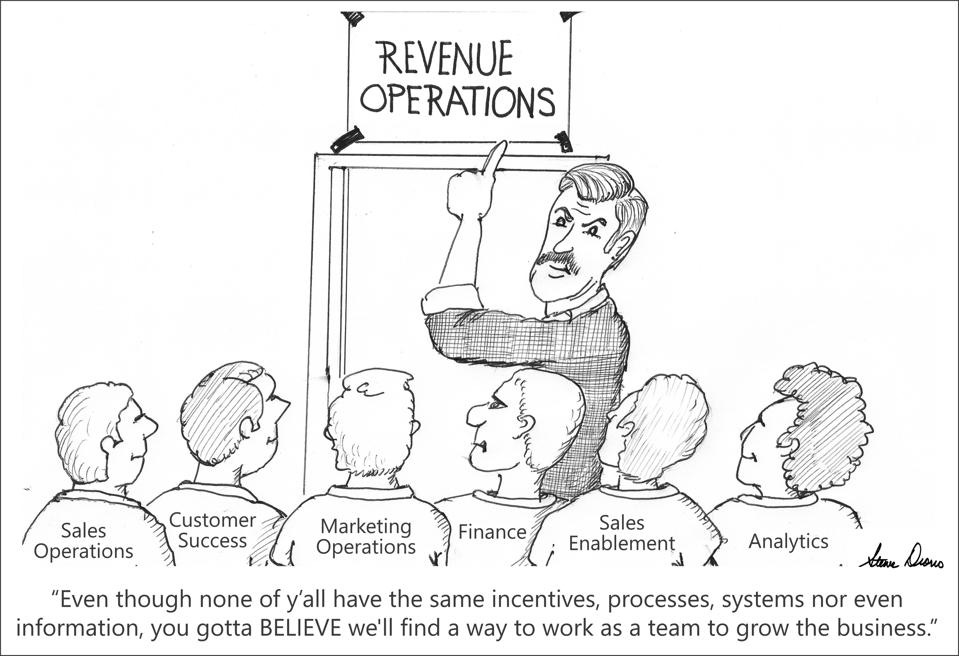While you've been celebrating your "modern" RevOps stack, AI has quietly made 80% of traditional Ops roles obsolete.
The companies that figure this out first will leave everyone else scrambling to catch up.
Most leaders are still thinking in old categories: Sales Ops, RevOps and GTM Operations.
The real game has already moved to AI RevOps.
The transition happened faster than anyone expected, and the winners aren't the ones with the biggest ops teams. They're the ones who saw the writing on the wall and completely reimagined how revenue operations actually work.
Sales Ops: The Siloed Nightmare (1970s-2015)
Sales Operations was born at Xerox in the 1970s when J. Patrick Kelly created a group to handle "all the nasty number things you don't want to do but need to do to make a great sales force." Territory design, compensation planning, forecasting, and all the foundational work that made sales teams function.
For decades, this model worked. Sales Ops teams were the engine room that kept sales running smoothly.
But as SaaS businesses exploded and go-to-market motions became more complex, the cracks started showing.
The old model became a bottleneck. Sales Ops lived in isolation, reporting up through sales leadership, fighting for scraps of marketing data, and spending 70% of their time on manual reporting instead of actual strategy.
Meanwhile, marketing had their own Ops person doing completely different things with completely different tools.
Companies that clung to siloed ops teams watched their growth plateau while competitors with integrated operations pulled ahead.
You can't scale chaos.
The lesson was becoming clear: Operational alignment drives revenue growth more than any single channel or tactic.
RevOps: The Great Unification (2015-2022)
RevOps emerged in the mid-2010s as the answer to siloed operations chaos. Finally, one team, one system, one source of truth across marketing, sales, and customer success.
RevOps solved the coordination problem but created a new one.
Now you had one team trying to be experts in demand gen, sales methodology, customer onboarding, pricing strategy, and about fifteen different software platforms.

The most successful RevOps teams weren't the ones with the best operators. They were the ones who automated themselves out of 90% of their manual work. RevOps breaks down the walls between organizations that impact company revenue.
But the real winners built systems that ran themselves and focused on strategy instead of data entry.
RevOps teams accidentally discovered the future: Operations that think for themselves…enter GTM Ops.
GTM Operations: The Brief Moment of Glory (2022-2024)
GTM Ops emerged as the natural evolution: Bigger scope, more strategic, focused on the entire go-to-market engine instead of just the handoffs between departments.
The key difference?
RevOps asks "how do we optimize revenue?"
GTM Operations asks "how do we win in the market?"
While RevOps focused on aligning sales, marketing, and customer success around revenue metrics, GTM Operations took ownership of market strategy, competitive positioning, pricing optimization, and the complete customer journey from awareness to advocacy.
GTM Operations emerged around 2023 as companies realized RevOps was still too narrow.
GTM Ops became the strategic brain of the entire go-to-market engine.
These teams owned everything from ideal customer profile research to competitive intelligence to post-sale expansion playbooks. They became the orchestrators of market success, not just revenue optimization.
But there was a plot twist: The best GTM Ops teams spent most of their time building:
AI-powered workflows
Customer segmentation models
Predictive lead scoring
Automated competitive intelligence
Dynamic pricing recommendations based on market conditions
They weren't just doing operations…they were training their replacements.
The companies that leaned hardest into AI-powered GTM operations saw 19% faster revenue growth than their peers.
Not because they had better operators, but because they had operations that never slept, never made human errors, and got smarter over time.
AI RevOps: The Operating System Takeover (2024+)
Most companies think AI RevOps means "AI tools for RevOps teams."
❌ Wrong!
AI RevOps happens when revenue operations teams become AI orchestrators and strategists, not manual executors.
The AI handles data analysis, workflow automation, predictive modeling, and real-time optimization.
Humans handle strategy, creative problem-solving, and steering the AI toward business outcomes.
Real AI RevOps looks like this:
Autonomous lead qualification that's more accurate than your best sales rep
Dynamic pricing models that adjust based on market conditions, competitor moves, and individual customer behavior
Self-optimizing email campaigns that test subject lines, timing, and content automatically
Predictive churn models that identify at-risk customers before your CS team does
Automated competitive intelligence that tracks every competitor move and adjusts your strategy in real-time
The data is staggering:
75% of GTM teams have access to AI, but only 29% report using it extensively.
Yet 97% of AI users report positive impact on achieving their goals. The companies building this advantage aren't hiring more Ops people.
They are hiring AI engineers and prompt specialists.
RevIntelligence vs. AI RevOps: Know the Difference
Most companies think they're doing AI RevOps when they're actually just doing RevIntelligence.
Here's the critical distinction that separates the two:
RevIntelligence is AI that watches your revenue process and gives you insights. For example, platforms like Gong, Chorus, Clari will analyze sales calls. AI tells you what happened and why deals were won/lost.
You still do the work. AI just makes you smarter about it.
AI RevOps is AI that is your revenue process. AI will make decisions and take actions without human intervention. This includes tasks such as autonomous lead qualification, automated workflow execution and self-optimizing campaigns.
AI is the operational engine, not just the intelligence layer. AI does the work while you orchestrate the strategy.
Think of it this way:
RevIntelligence tells your sales rep which deals to focus on.
AI RevOps automatically nurtures the low-priority deals until they're ready for human attention.
Most companies today use RevIntelligence tools but still operate with manual RevOps processes.
The winners are moving from "AI tells us what to do" to "AI does it for us."
RevIntelligence platforms become components of your AI RevOps stack, but they're not the whole picture.
How to Build Your AI-powered RevOps Department (Before Your Competition Does)
Step 1: Stop hiring traditional ops roles immediately.
The skills that made someone great at RevOps (manual process optimization, spreadsheet wizardry, tool administration) are becoming obsolete faster than you think.
Step 2: Start with your data foundation.
AI RevOps is only as good as your data architecture. You need clean, connected, real-time data flowing between all revenue systems. Hire a Data Engineer before you hire another Ops Analyst.
Step 3: Recruit AI-native operators.
Look for people who understand both business strategy and hands-on implementation. These aren't traditional Ops people. They are business-minded implementers who got technical enough to solve their own problems. Former consultants who built their own Zapier automations to eliminate manual work. Marketing ops people who've set up complex integrations and understand APIs. Sales ops managers who've built custom Salesforce workflows and know when to use automation vs. human touch.
Step 4: Build your core team around three roles:
Your existing RevOps people don't disappear…they evolve into more strategic roles while AI handles the tactical execution. But stop hiring traditional RevOps analysts and start adding these AI-focused roles that will augment your current team:
AI RevOps Strategist: Defines what problems AI should solve and measures business impact
AI Implementation Specialist: Builds and maintains AI workflows, prompt engineering, model training
Data Operations Engineer: Ensures data quality and system integrations that feed the AI
Step 5: Pick one high-impact use case and go deep.
Don't try to AI RevOps everything at once. Pick your biggest operational bottleneck (maybe it's lead qualification, maybe it's customer health scoring) and build an AI solution that completely eliminates human involvement.
Step 6: Partner with AI vendors, don't build everything in-house.
Buy don’t build. Look for platforms that offer native AI workflow automation, not just analytics. You need systems that can execute actions autonomously, i.e. automatically qualifying leads, updating deal stages based on behavior, triggering personalized outreach sequences, and adjusting forecasts in real-time. Your competitive advantage isn't building AI from scratch. It's orchestrating AI systems to drive business outcomes.
Step 7: Measure AI impact, not AI adoption.
Track these specific KPIs that show AI is actually driving business results:
Speed Metrics:
Lead qualification time (should drop from days to minutes)
Time from lead to first meaningful interaction (automated vs. manual)
Deal progression velocity through pipeline stages
Accuracy Metrics:
Forecast accuracy improvement (AI predictions vs. human predictions)
Lead scoring precision (conversion rate of AI-qualified vs. human-qualified leads)
Churn prediction accuracy (early warnings that actually prevent churn)
Efficiency Metrics:
Manual hours eliminated per week (concrete time savings)
Percentage of routine decisions made autonomously by AI
Revenue per operations team member (productivity multiplier)
Proactive Impact Metrics:
Revenue opportunities identified by AI that humans missed
At-risk accounts flagged and saved before human detection
Competitive threats identified and addressed proactively
If your AI RevOps isn't showing measurable improvement in these areas within 90 days, you're not doing AI RevOps.
You're just doing traditional RevOps with expensive software.
Final Thoughts
The evolution from Sales Ops to AI RevOps isn't just about better tools.
It's about fundamentally reimagining how revenue operations work.
By investing in systems that think, learn, and optimize themselves.
Each phase solved the problems of the previous one, but created new challenges that demanded the next evolution.
Sales Ops gave us process.
RevOps gave us alignment.
GTM Operations gave us strategy.
AI RevOps gives us intelligence that scales infinitely
The transition from traditional Ops to AI RevOps isn't coming. It's already here.
Your choice is simple: Lead the transition or get left behind by it.
#AIOps #RevOps #GTM #FutureOfWork #AIStrategy #TechOps #SalesOps
What critical revenue signals is your business missing right now because your ops team is stuck aggregating data instead of interpreting it?
Drop it in the comments ⬇️
Let’s build smarter.
– Angela
♻️ Repost to help someone in your network unlock growth through no code and automation.
Follow Angela Stewart for more.
Subscribe here 👇





